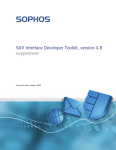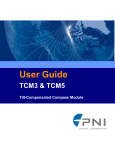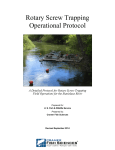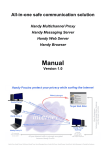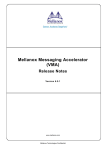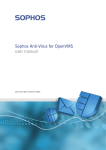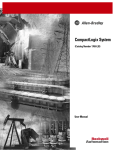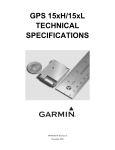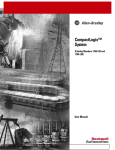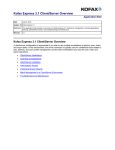Download SAV Dynamic Interface user manual
Transcript
SAV Interface Developer
Toolkit
SAV Dynamic Interface
user manual
Product version: 2.3
Document date: February 2015
Contents
1 SAVDI.......................................................................................................................................3
1.1 Introduction.................................................................................................................3
1.2 Features......................................................................................................................3
1.3 Command Line (*nix)..................................................................................................4
1.4 Command Line (Windows).........................................................................................4
1.5 Installing SAVDI..........................................................................................................5
1.6 Architecture.................................................................................................................5
1.7 Denial of Service Protection.......................................................................................6
1.8 Internationalisation.....................................................................................................7
1.9 Logging.......................................................................................................................7
1.10 Scanning permissions..............................................................................................8
1.11 Security.....................................................................................................................8
1.12 Exit modes................................................................................................................9
1.13 Signals (*nix)...........................................................................................................10
1.14 Virus and Engine Updates......................................................................................11
2 Configuration Options.............................................................................................................12
2.1 Configuration file errors............................................................................................13
2.2 Options Summary.....................................................................................................13
2.3 Daemon....................................................................................................................13
2.4 Log............................................................................................................................15
2.5 Channel....................................................................................................................16
2.6 Service......................................................................................................................17
2.7 Commprotocol..........................................................................................................17
2.8 Scanprotocol.............................................................................................................19
2.9 Scanner....................................................................................................................23
3 Appendix: Return Codes........................................................................................................25
4 Appendix: REJect Codes........................................................................................................26
5 Appendix: SAV Dynamic Interface Performance....................................................................27
6 Appendix: rc file for *nix..........................................................................................................29
7 Legal notices..........................................................................................................................31
2
SAV Dynamic Interface user manual
1 SAVDI
1.1 Introduction
The SAV Dynamic Interface (SAVDI) is a daemon on *nix systems or service on Windows systems
providing a networked interface to SAVI and the virus engine. It thus enables programs written
in any language on any system with networking capability to scan files and data for malware.
SAVDI clients can use the ICAP, SSSP or Sophie protocols. The SSSP and Sophie protocols are
described in the SAV Interface Sophos Simple Scanning Protocol User Manual. ICAP is defined
in RFC 3507 and the RFC 3507 errata.
Note: Sophie was developed by Vanja Hrustic as a free open source project to provide daemon
access to the Sophos virus engine.
1.1.1 Changes since earlier versions
Changes since version 1.0
The open standard protocol, ICAP, has been added with configuration options and structure
appropriate for ICAP.
There have been no other changes.
1.2 Features
■
Implemented on Unix/Linux and recent versions of Windows. Windows 9x is not supported.
■
Implements ICAP, SSSP and also provides Sophie functionality for compatibility.
■
Scans can be aborted if the server detects a problem, or if the client breaks the connection.
■
Limits the possibility for Denial of Service (DoS) whether by the use of problem files or by
hogs.
■
Updates to virus data can be achieved smoothly.
■
Communication is via configurable TCP ports, Unix domain sockets and Windows named
pipes.
See the SSSP and Sophie protocol descriptions for the functionality that they provide.
See the SAVDI ICAP Implementation document for details of ICAP as implemented in SAVDI.
Also see RFC3507 for the definition of ICAP.
3
SAV Interface Developer Toolkit
1.3 Command Line (*nix)
SAVDI can be run as an ordinary command line process or as a daemon using the -d switch.
There is a slight difference in behaviour between the two run modes: if it is running as a daemon
SAVDI will under some circumstances respawn itself (see below), but not otherwise.
If SAVDI is run in a non-daemon mode it can be interrupted and stopped with a CTRL-C from the
keyboard.
savdid [-d] [-c config] [-l] [-p] [-s]
-d will cause the process to switch to daemon mode.
-c specifies a configuration file other than the default.
-f specifies a pid file.
-l will cause logging to be sent to the console provided -d is not used.
-p will print details of the configuration file format and exit.
-s will suppress the initial version and copyright messages.
By default savdid runs as an attached process and will only switch to daemon mode if -d is
specified. savdid will not respawn itself if it is not running as a daemon.
The default locations for the configuration file are /usr/local/savdi./savdid.conf and
/etc/savdi/savdid.conf in that order of priority.
1.4 Command Line (Windows)
SAVDI can be run as an ordinary command line process or as a Windows service.
If SAVDI is run in command-line mode it can be interrupted and stopped with a CTRL-C from the
keyboard.
savdid [-c config] [-l] [-v] [-h]
-c specifies a configuration file other than the default.
-l will cause savdid to send logging to the console if running in command-line mode.
-v will display version and copyright information and then exit.
-h will display usage information and then exit.
By default savdid runs as an attached process and will only run as a service if it has been installed
as such.
If the -c command-line argument is omitted, savdid will check the registry for the following string
value:
HKEY_LOCAL_MACHINE\SOFTWARE\Sophos\Savdid\ConfigurationPath
If this value is present, it’s value will be interpreted as the path of the configuration file. If the -c
command-line argument is omitted and the above registry value is absent, savdid will search its
own directory for savdid.conf.
To install savdid as a service, use the following commands:
4
SAV Dynamic Interface user manual
Command
Description
savdid -install
Installs savdid as a service.
savdid -uninstall
Uninstalls the savdid service.
savdid -reinstall
Equivalent to savdid -uninstall followed by savdid
-install.
savdid -start
Starts the savdid service.
savdid -stop
Stops the savdid service.
1.5 Installing SAVDI
A SAVDI installation consists of:
■
The savdid executable.
■
A DLL for Windows Event Log messages, message.dll file.
■
A sample savdid.conf configuration file.
■
A language file, savdidlang_en.txt.
For *nix, savdid may be placed anywhere but the default locations for the savdid.conf and
savdidlang_en.txt files are /usr/local/savdi and /etc/savdi. The location for the
configuration file may be overridden by a command line option.
For Windows the savdid.conf and savdidlang_en.txt files are placed, and expected to be in the
normal installation folder. However the location of the configuration file may be overridden by a
command line option.
Create the configuration file either from scratch or by copying and editing the sample configuration.
To verify the configuration file initially run savdid as a command line executable with the log to
console switch:
./savdid -l [-c config-file]
Use the -c switch to specify the configuration file if it is not in the standard location.
This makes debugging the configuration file simpler as errors are reported to the console.
Check the operation of savdid by running one or more of the sample applications from another
terminal session. Once savdid is running as desired it can be run as a daemon or service.
1.6 Architecture
On Windows savdid runs as a single process either from the command line or as a service.
On *nix it will also run as a single process if run in non-daemon mode. However if run in daemon
mode it will run as two processes, a parent and child. The parent spawns the child process,
5
SAV Interface Developer Toolkit
controlling and monitoring it. The parent is the one that will respond to signals, spawning new
child processes as requested, and terminating the old ones. Also, if the child process should exit
unexpectedly, the parent will start a new one, maintaining the service.
On all platforms, the process providing the scanning service has a main thread with a configurable
number of session, or worker, threads.
The main thread fields the initial connections from the clients which are queued to the session
threads. An idle session thread will pick up the connection and handle the rest of the communication
with the client until disconnection.
Any number of channels may be defined, a channel consisting of: a communications port defining
the transport mechanism to be used; the definition of the protocol to be used; the definition of the
SAVI object to be used. Each channel can support any number of clients, if permitted by the
transport mechanism.
To minimise a session’s startup time SAVI objects are pre-allocated and initialised.
SAVDI provides for multiple:
■
Protocols (ICAP, SSSP and Sophie have been implemented).
■
Transport mechanisms (TCP/IP, unix domain sockets and Windows named pipes have been
implemented).
■
Logging mechanisms (to the console, to a daily log file to syslog on *nix systems).
■
Languages.
1.7 Denial of Service Protection
There is no protection against the daemon being flooded with scan requests denying service to
legitimate clients however, there are some measures that can be taken to limit the effect of
accidental and malicious DoS attacks.
Timers can be used to limit the effect of careless usage:
■
There is a configurable time limit imposed on a scan.
■
There is a configurable time limit imposed on a request.
■
There are timeouts on sending and receiving data from the client.
■
An idle timer closes the connection if the client is silent for too long.
Unidentified protocol requests will cause the connection to be closed.
Remote connections can be restricted to a subnet.
If a client disconnects during a scan, the scan will be aborted.
Administrators can create channels with different ownership and protections, and with different
properties such as timeouts, allowing for different classes of client. Multiple versions of the daemon,
with different configuration files, can be run further enhancing the separation of clients.
Memory faults and similar exceptions are caught and will cause savdid, if it is running in daemon
mode, to spawn a new version of itself to handle new connections, while the old daemon completes
its current work as possible before it exits.
6
SAV Dynamic Interface user manual
savdid has an internal pending connection queue. Once the queue is full any further connections
will be rejected. This means the maximum number of connections to savdid is the no of threads
+ the maximum length of the queue.
When scanning directories there is no protection built in from a link which loops back in the
directory tree. However on *nix systems soft links are ignored and provided hard links are only
permitted to files and not directories this possibility is precluded.
1.8 Internationalisation
Log messages, including SAVI result codes, are available for translation, or amendment. The
language as defined by the locale is used by default if it is available. If it is not available, or if a
translation of a message is not available the English version will be used instead.
Note: Presently only the English version of the text is available.
1.9 Logging
savdid has a single logger for all log messages. The log is sent to any one of a set of configurable
destinations, the console, a file, or on *nix systems, the syslog. A log entry consists of a message,
represented by a number and a list of parameters. The message number is converted to a text
string before the message is output
On *nix systems the parent process, in daemon mode, will always log significant events to the
syslog.
Savdid logs the following events, in order of priority:
1. Errors and Detected threats.
2. Startup and shutdown of savdid.
3. Start and end of connections and sessions.
Savdid can be configured to limit the events it logs according to the above priority. Level 0 events,
which are always logged, are the errors and threats. The default level is level 2 and includes
savdid startup and shutdown events.
In addition, individual channels can be requested to log requests from clients. This is independent
of the selected logging level.
All log entries include a timestamp and events relating to client communications also include a
unique serial number which identifies the session and request. This serial number is the same
number specified in the SSSP ACC message.
If the log entry is recording a threat the threat name will be enclosed in single quotes and the
location of the threat will be enclosed in double quotes. Should the location of the threat include
a double quote, the double quote will be preceded by a double quote.
When logging to a serial file the log files are named with the date and a new one is started at
midnight.
For more information, see Log (page 15).
The message number in a log message is translated before output.The translations are contained
in a configurable directory, which can contain more than one translation file. The file to be used
7
SAV Interface Developer Toolkit
for translation is also configurable. If a message number cannot be translated the translation file
‘en’ (English) is used, and if that also fails, the number itself is output.
1.10 Scanning permissions
The following only applies to the SSSP and Sophie protocols as they allow scanning of files and
whole trees on the server system.
SSSP and Sophie allow scanning by sending either the name of a file, or by sending the contents
to be scanned. SSSP has different requests, SCANFILE and SCANDATA. Sophie limits scanning
by file and scanning by data according to the transport mechanism. With Sophie scanning by data
is required for IP connections and scanning by filename is required for Unix domain sockets and
Windows named pipes. SSSP allows both on any transport mechanism. However, the configuration
for SSSP includes options to disallow scanning by file and scanning by data by channel
(allowscanfile and allowscandata).
SSSP and Sophie also permit the scanning of directories if allowed. Sophie will accept a directory
specification instead of a file specification and scan the directory and sub-directories. SSSP has
specific requests for scanning a directory and for scanning sub-directories, SCANDIR and
SCANDIRR. For both protocols the ability to scan directories and to scan sub-directories are
separately controlled by configuration options, allowscanfile for SSSP and allowscandir for Sophie.
Note that the SSSP scan directory requests permit the use of a file name instead of a directory
name, whereas a scan file request does not permit the use of a directory name.
For more information, see Scanprotocol (page 19).
Irrespective of the protocol, only files and directories will be scanned, other types of file system
object, for example symbolic links will be ignored or rejected.
For the SSSP SCANFILE, SCANDIR, SCANDIRR, and Sophie scan file by file name requests it
is possible to limit the areas that may be scanned. The configuration options ‘deny’ and ‘allow’
permit the administrator to prevent scanning of directories (/dev on *nix systems may be denied,
for example), or to limit clients to an allowed area. The logic is:
1.
2.
3.
4.
If the requested path is denied, deny the request.
If the requested path is allowed, allow the request.
If there are any allowed paths, deny the request.
Allow the request.
While the first and second tests are obvious, the third one means that an allow option will limit all
requests to that sub-tree, allowing the administrator to set up a special scanning directory, say.
This is intended to provide for either a restrictive system where only specific areas are allowed,
or a permissive system where specific areas are denied, so that in general only either the allow,
or the deny options would be used. Mixing allow and deny options is not recommended.
For more information, see Scanner (page 23).
1.11 Security
At the process level:
■
8
savdid will accept only a configurable number of concurrent sessions.
SAV Dynamic Interface user manual
At the channel level:
■
TCP/IP sockets can be limited to a specific sub-set of IP addresses from which connections
will be accepted.
■
To allow or deny the ability to scan by filename or scan by data if SSSP is used. The ability
to scan directories and to recurse into sub-directories is also configurable and for all application
protocols.
■
Timeouts in seconds can be set for:
■
■
Idle time between client requests.
■
Wait time for a receive to complete.
■
Maximum time allowed for a file scan to complete.
■
Maximum time allowed for a request to complete.
The maximum amount of data that may be sent for scanning.
Note: There is no encryption so network socket users have no protection from network sniffers.
1.11.1 Security (*nix)
At the process level:
■
savdid, if run from a super-user account, can switch to running as a configurable user.
■
savdid will refuse to scan a file for which the user of a unix domain socket client, does not
have read permissions where possible.
At the channel level:
■
Unix domain sockets can be created with configurable ownership and permissions.
1.11.2 Security (Windows)
At the process level:
■
savdid impersonates the client of a named pipe connection and attempts all file accesses from
within that security context.
1.12 Exit modes
savdid has three ways of exiting:
■
Ungracefully - The process exits immediately.
■
Request gracefully - It will complete all current requests before disconnecting from the client
and exiting when all have finished. New connections are rejected.
■
Session gracefully - It completes all current sessions and exits when all have completed. New
connections are rejected.
The choice between these three modes of exiting is configurable using the onrequest daemon
option.
9
SAV Interface Developer Toolkit
1.13 Signals (*nix)
The daemon will trap and respond to the following signals:
Signal
Action
SIGINT
To exit immediately and without waiting for any
completions, i.e. the daemon will exit ungracefully.
SIGTERM
To finish gracefully, waiting for current requests or
sessions to complete according to the onrequest
configuration option.
SIGHUP
To spawn a new daemon which will handle new
connections while the old one finishes the current
requests or sessions, depending on the onrequest
configuration option, before exiting. The new
process will reload the configuration file and virus
data.
If savdid is not running in daemon mode it will not
spawn a new process but will exit according to
the value of the onrequest configuration option.
In addition the daemon traps exceptions and signals originating in the virus engine and will treat
it as if a SIGHUP signal had been received, except that the exit mode will depend on the
onexception configuration option. The onexception option is similar to the onrequest option.
This table summarises these actions:
Signal
Respawn?
Exit mode
INT
No
Immediate
TERM
No
onrequest option
HUP
Yes (if in daemon mode)
onrequest option
Non-recoverable error
Non-recoverable error
Yes (if in daemon mode)
onexception option
To enable the correct savdid process to be signalled, savdid writes its process ID, pid, to a file
from which it can be read and used for signalling. The pid file may be specified on the command
line or in the configuration file. If it is not specified at all, the default is /var/run/savdid.pid.
This shell command line will correctly signal the daemon, if using the default pid file:
10
SAV Dynamic Interface user manual
$ kill -HUP `cat /var/run/savdid.pid`
Note: The quotes used with pid file are back quotes, not single quotes.
1.13.1 Moribund processes (*nix)
On occasion savdid daemon will either exit or restart itself as a result of a request or an exception.
When restarting, the new savdid will take on new connections, while the old one completes its
current work. So before it fully exits, the old savdid will enter a moribund state while it waits for
current work to complete. Depending on circumstances, it is possible for there to be more than
one moribund process though such circumstances should be very rare.
The parent process monitors the number of child processes and will forcibly terminate the older
processes when the number of child processes exceeds five, i.e. one active and four moribund.
See the onexception and onrequest configuration options.
1.14 Virus and Engine Updates
On Windows, provided the host system has the Sophos automatic updates included, the savdi
service will automatically be updated with the latest virus data and version of the virus engine. If
there is no automatic updating then the service must be stopped and re-started to load the latest
version of the virus data and engine.
On *nix systems, the daemon can be signalled with a HUP signal to cause it to reload the virus
data and the SAVI library: libsavi, which includes the engine. For more information about this
signal, see Signals (*nix) (page 10). Note that although the child process will use the new SAVI
library, the parent process will continue to use the original one.
11
SAV Interface Developer Toolkit
2 Configuration Options
The configuration file syntax is essentially a list of name/value pairs which are grouped into named
sub-configurations that define the configuration of well-defined elements of the daemon.
Sub-configurations can in turn contain sub-configurations. Syntax is:
<statement list> := <statement> {<statement list>}
<statement> := <option> | <subconfiguration>
<subconfiguration> := <name> “{“<eol><statement list> “}”<eol>
<option> := <option name><option sep><value><sep> <value list><eol>
<value list> := [|<value><value list>]
<option sep> := “:”
<sep> := <spaces>
<eol> represents the end of the line.
<spaces> represents one or more space characters.
Comments start with a “#” and end at the end of line and are ignored.
As an example, this is a fragment from a savdid configuration file:
user: savdid
group: savdid
threadcount: 3
onrequest: REQUEST
onexception: DONTWAIT
log {
type: FILE
logdir: /var/log/savdid/log
loglevel: 0
}
channel {
commprotocol {
type: IP
address: 172.18.33.14
port: 4010
subnet: 172.18.33.0/24
# etc
}
scanprotocol {
type: SSSP
allowscandata: YES
allowscanfile: NO
# etc
}
12
SAV Dynamic Interface user manual
scanner {
type: SAVI
savigrp: GrpInternet 1
deny: /dev
# etc
}
}
channel {
# etc
}
2.1 Configuration file errors
When savdid starts it will do some checks on the configuration and may display one or more
errors. The errors have the following format:
<lineno>: <option name>: <option value>: <error message>
The <option name> will include the sub-configurations, if any, where the option is located. So for
example "channel[3]-scanner[1]-deny" specifies the deny option in the first scanner
sub-configuration of the third channel.
2.2 Options Summary
In the following tables, the columns are:
Option - the option name and the format of the option.
N - the cardinality of the option, ie how many there can or should be. A single number (usually
'1') indicates that there must be that number of options present. A range, 0..1 for example, indicates
the minimum and maximum number of occurrences. The example, 0..1 is for something that can
occur at most once. 1..N means that it must occur at least once but there is otherwise no limit.
Default - the default value if there is one. '-' indicates that there is no default.
Comment - self-explanatory.
2.3 Daemon
Option
N
Default
Comment
pidfile: <filename>
0..1
/var/run/savdid.pid
For *nix systems, Where
savdid will store the
process ID of the
controlling process. If a
pidfile is specified on the
command line, the
13
SAV Interface Developer Toolkit
Option
N
Default
Comment
command line will take
precedence.
14
user: <user name>
0..1
-
For Unix systems. The
user to switch to on start
up. See note 1.
group: <group name>
0..1
-
For Unix systems. The
group to switch to on start
up. See note 1.
threadcount: N
0..1
3
The number of threads to
use and hence the
maximum number of
concurrent scans.
maxqueuedsessions
0..1
0
The maximum number of
connections/sessions to
queue to be queued
internally. 0 means there
will be no queueing.
virusdatadir: <dir name>
0..1
Defaults to SAVI default
Where to find the virus
data. See note 2.
virusdataname <name>
0..1
Defaults to SAVI default
The name of the main
virus data file, without its
extension. See note 2.
idedir: <dir name>
0..1
Defaults to SAVI default
Where to find the IDE
files. See note 3.
onexception:
"DONTWAIT"|
"REQUEST"|SESSION"
0..1
"REQUEST"
What to do when exiting
as a result of an
exception. See note 3.
onrequest: "DONTWAIT"| 0..1
"REQUEST"|SESSION"
"SESSION"
What to do when exiting
as a result of a request to
exit. See note 3.
log
-
The sub-configuration for
logging.. See note 4.
0..1
SAV Dynamic Interface user manual
Option
N
Default
Comment
channel
1..N
-
The sub-configuration for
the communication
channels.
Note:
1. To change user or group, the daemon must have suitable privileges, and possibly running as
super-user.
2. The virusdatadir, virusdataname and idedir options can also be set using the savistr options
in the channel scanner configuration. However since the virus data is common to all this is not
advised. In such a situation the set of virus data that will be used is undefined.
3. When exiting the daemon can exit immediately without waiting, or it can wait for the current
requests to complete, or it can wait for the current sessions to complete. The choice depends
on the circumstances (exception or request) and in particular whether sessions are long running
or not.
4. If a log configuration is not specified the logging is to either the console of system/event log
depending on whether the daemon is running interactively or not.
2.4 Log
Option
N
Default
Comment
type: "FILE"|"CONSOLE" 0..1
|"SYSLOG"
See note 1.
logdir: <directory name>
0..1
-
Where to write the log
files if FILE is specified.
See note 2.
loglevel: <level>
0..1
2
The level of event logging
required. Level 0 is the
minimum and includes
errors and threats. Level
2 includes everything.
Note:
1. The log type defaults depending on whether or not logdir is defined: if it is defined FILE is
assumed, if not CONSOLE is assumed.
2. Log files are named yymmdd.log and a new file is started with the first log message after
midnight.
15
SAV Interface Developer Toolkit
2.5 Channel
Configuration options per channel for SSSP and SOPHIE:
Option
N
Default
Comment
commprotocol
1
-
The sub-configuration
defining the transport
protocol to be used.
scanprotocol
1
-
The sub-configuration
defining the application
protocol to be used.
scanner
1
-
The sub-configuration
defining the scanner.
Option
N
Default
Comment
logrequests: YES|NO
0..1
NO
If YES causes all
requests from the client
to be logged.
commprotocol
1
The sub-configuration
defining the transport
protocol to be used.
service
1..N
The sub-configuration
defining the service.
Or, if using ICAP:
16
SAV Dynamic Interface user manual
2.6 Service
Option
N
Default
Comment
name: <service name>
1
-
The name of the service.
type: <service type>
1
-
The type of the service.
For now it can only be
“avscan”.
scanprotocol
1
-
The sub-configuration
defining the application
protocol to be used. See
the ICAP scanprotocol
variant below.
scanner
1
-
The sub-configuration
defining the scanner.
2.7 Commprotocol
The options for the commprotocol configuration depend on the choice of transport: IP, Unix or
Pipe.
IP
Option
N
Default
Comment
type: "IP"
1
-
Specifies TCP/IP as the
transport layer.
address: <ip address>
0..1
0.0.0.0
Specifies the IP address
for the socket to bind to.
port: N
1
-
Specifies the port no. to
use for an IP channel (1
to 65535).
17
SAV Interface Developer Toolkit
Option
N
Default
Comment
subnet: <ip
address>/<subnet>
0..1
-
The client IP addresses
from which the daemon
will accept connections.
<subnet> is the number
of significant bits in the
address and so is in the
0 to 32.
requesttimeout: N
0..1
-1
The timeout when waiting
for a new request in
seconds. -1 means wait
forever.
sendtimeout: N
0..1
5
The timeout for sending
in seconds.
recvtimeout: N
0..1
5
The timeout for receiving
in seconds.
Option
N
Default
Comment
type: "UNIX"
1
-
Specifies a Unix domain
socket as the transport
layer.
socket: <filename>
1
-
The file name for the
socket for a UNIX
channel. Not used
otherwise.
user: <user name>
0..1
Daemon user
The user name for
ownership of the socket.
group: <group name>
0..1
Daemon group
The group name for
ownership of the socket.
mode: <mode>
0..1
user
One of user, group, all
specifying who may use
the socket.
UNIX
18
SAV Dynamic Interface user manual
Option
N
Default
Comment
requesttimeout: N
0..1
-1
The timeout when waiting
for a new request in
seconds. -1 means wait
forever.
sendtimeout: N
0..1
5
The timeout for sending
in seconds.
recvtimeout: N
0..1
5
The timeout for receiving
in seconds.
Note: To set user, group and protections on a socket, the daemon must have suitable privileges,
and possibly running as super-user
Pipe
Option
N
Default
Comment
type: "Pipe"
1
-
Specifies a Windows
named pipe as the
transport layer.
name: <name>
1
-
The name for the named
pipe.
requesttimeout: N
0..1
-1
The timeout when waiting
for a new request in
seconds. -1 means wait
forever.
sendtimeout: N
0..1
3
The timeout for sending
in seconds.
recvtimeout: N
0..1
3
The timeout for receiving
in seconds.
2.8 Scanprotocol
SSSP and Sophie
19
SAV Interface Developer Toolkit
20
Option
N
Default
Comment
type: "SSSP"|"SOPHIE"
1
-
Specifies the scan
protocol to be used.
tmpfilestub: <partial file
name>
0..1
-/tmp/savdid_tmp
Specifies the directory
and file name stub to be
used for temporary files
used when scanning data
sent to the server - see
maxmemoryscansize
below.
maxscandata: N
0..1
0 (unlimited)
In bytes the maximum
amount of data a client
can send for scanning.
maxmemorysize: N
0..1
250000
The maximum size of
data from the client before
using a temporary file
instead. See tmpfilestub
above.
allowscanfile:
0..1
"NO"|"FILE"|"DIR"|"SUBDIR"
NO
For SSSP only. Specifies
the level of scanning a
client is permitted. NO
means none at all, FILE
means only explicit files
may be scanned, DIR
means a directory or file
may be scanned,
SUBDIR means that
sub-directories will also
be scanned. See notes
(1) and (2).
allowscandir:
"NO"|"DIR"|"SUBDIR"
NO
For SOPHIE only.
Specifies the level of
scanning a client is
permitted. NO means that
directories cannot be
scanned, DIR means a
directory or file may be
scanned, SUBDIR means
that sub-directories will
also be scanned. See
note (1).
0..1
SAV Dynamic Interface user manual
Option
N
Default
Comment
allowscandata:
"YES"|"NO"
0..1
NO
For SSSP only. Allow the
client to send data for
scanning. See notes (1)
and (2).
logrequests: "YES"|"NO" 0..1
NO
Log all client requests.
Note:
1. The allowscanfile and allowscandata options do not apply for Sophie as the protocol will only
allow scanning by filename on Unix domain sockets and scanning by data on TCP/IP sockets.
2. SSSP will enable the requests SCANDATA, SCANFILE, SCANDIR and SCANDIRR according
to the settings of these options.
ICAP
Option
N
Default
Comment
type: ICAP
1
-
Specifies ICAP as the
protocol.
version: <version>
0..1
XXX
The version of this
configuration. Change it
whenever a change is
made that may alter the
results sent to the client.
retain: NONE|MALWARE| 0..1
PROBLEM|ALL
NONE
Optionally retain files
containing malware or
which have caused the
engine a problem for
diagnosis. The files are
named and placed
according to the
tmpfilestub below.
dontsend: <extension list> 0..1
“”
A string containing a list
of file extensions that will
be sent as entered to a
client in the OPTIONS
response.
allow204: YES|NO
NO
An ICAP option used to
tell the client that the
0..1
21
SAV Interface Developer Toolkit
Option
N
Default
Comment
server may return a 204
response.
22
keepalive: YES|NO
0..1
NO
Tells the server to keep a
connection open when it
completes a transaction.
maxbodysize: N
0..1
0
The maximum size in
bytes of the body of a
request that the server
will accept. Zero indicates
that any size is
acceptable.
maxmemorysize: N
0..1
1000000
The maximum amount of
memory in bytes that will
be used to store the body
of a request before the
server uses a temporary
file instead.
maxchunksize: N
0..1
0
The maximum size of the
chunks that the server will
return to the client. Zero
indicates that the chunks
may be any size.
tmpfilestub: <file stub>
0..1
See note 1 below
The directory path and file
name stub for temporary
files.
block-bombs: YES|NO
0..1
YES
If a zip-bomb is detected
it will not be returned to
the client if YES
block-encrypted:YES|NO 0..1
NO
If an encrypted file is
detected it will not be
returned to the client.
block-corrupt: YES|NO
0..1
NO
If a corrupt file is detected
it will not be returned to
the client.
block-timeouts: YES|NO
0..1
YES
If it takes too long to scan
a file and the scan is
SAV Dynamic Interface user manual
Option
N
Default
Comment
aborted the file will not be
returned to the client.
block-errors: YES|NO
0..1
YES
If there is an error while
scanning the file, the file
is not returned to the
client.
block-exceptions:
YES|NO
0..1
YES
If the file causes an
exception, the file is not
returned to the client.
NO
At least one ICAP client
expects an empty body
even when unnecessary.
forceemptybody:YES|NO 0..1
Note:
1. On Windows the temporary directory is <standard temp directory>\SAVDI_ while on *nix
systems it is /var/tmp/SAVDI_. Note that this is also used for the retain option.
2.9 Scanner
Specifies the scanner and its configuration options.
Option
N
Default
Comment
type: "SAVI"
0..1
"SAVI"
Specifies the type of
scanner. For now only
SAVI is accepted.
inprocess: "YES"|"NO"
0..1
"YES"
Specifies whether the
scanner is in process or
not, the alternative is out
of process. For now only
"YES" is accepted.
maxscantime: N
0..1
-1 (unlimited)
Maximum time, in
seconds, to allow a scan
to complete.
maxrequesttime: N
0..1
-1 (unlimited)
Maximum time in seconds
to allow servicing a
request. This should be
23
SAV Interface Developer Toolkit
Option
N
Default
Comment
greater than or equal to
maxscantime.
deny: <directory name>
0..N
-
Specifies a directory
which is not allowed to be
scanned. All files and
sub-directories will be
barred.
allow: <directory name>
0..N
-
Specifies a directory
which is allowed to be
scanned. By implication
all other directories are
denied unless explicitly
allowed.
saviint: <name> <value>
0..N
-
Specifies a SAVI/Engine
integer (U16) option. See
Note 1.
savigrp: <name> <value> 0..N
-
Specifies a SAVI/Engine
group configuration
option. See Note 1.
savistr: <name> <value> 0..N
-
Specifies a SAVI Engine
string option. See Notes
1 and 2.
savists: <name> <value> 0..N
-
Specifies a SAVI/Engine
status (U32) option. See
Note 1.
Note:
1. savdid does not validate or verify the SAVI options; they are passed through to the SAVI
objects as given.
2. It is inadvisable to use these options to set the virus data directory and associated options.
These options should be set at the daemon level.
24
SAV Dynamic Interface user manual
3 Appendix: Return Codes
In addition to the SAVI return codes documented in savi_sen.pdf as part of the SAVI Developer
Toolkit, the following return codes can also be returned by the SAV Dynamic Interface in response
to a scan request:
Return Code
Description
060D
Engine exception. Please report the file to Sophos
Technical Support.
060E
Request terminated due to timeout. See the
maxrequesttime configuration option.
060F
Scan terminated due to timeout. See the
maxscantime configuration option.
25
SAV Interface Developer Toolkit
4 Appendix: REJect Codes
If SSSP rejects a request, the REJ message is accompanied by a numeric code indicating the
cause:
Code
Cause
1
The request was not recognised. After sending this
the server will disconnect.
2
The SSSP version number was incorrect.
3
There was an error in the OPTIONS list.
4
SCANDATA was trying to send too much data.
5
26
The request is not permitted.
SAV Dynamic Interface user manual
5 Appendix: SAV Dynamic Interface
Performance
The method used by the client to interact with the SAV Dynamic Interface will be constrained by
circumstances. Nonetheless the following are offered as guidelines in selecting the best method:
■
Connect and stay connected. There is a considerable overhead to establishing the connection,
and breaking it.
■
Use a Unix domain socket, or windows named pipe rather than TCP/IP. There is an extra
overhead using TCP/IP.
■
Avoid using a one-off script, i.e. executing a script for each scan. Not only is there the overhead
of making a new connection but also the overhead of starting the interpreter, script compilation,
and so on.
■
Use the SSSP OPTIONS request only if necessary, it is cheaper to have the options set in
the configuration file. If a client has different needs to other clients, create another channel
tailored for that client.
■
If possible scan a whole directory rather than making requests to scan each file.
To illustrate the differences in performance, the following table, ordered with the fastest first,
shows throughput of files being scanned relative to the fastest method (indexed at 100):
1. A C program which connects, scans a file 100 times, and disconnects is run once.
Option
Value
Unix domain socket
100
TCP/IP (localhost:4010)
97
2. A Perl script which connects, scans a file 100 times, and disconnects is run once.
Option
Value
Unix domain socket
83
TCP/IP (localhost:4010)
81
27
SAV Interface Developer Toolkit
3. A Perl script which connects, scans a file, and disconnects 100 times is run once.
Option
Value
Unix domain socket
56
TCP/IP (localhost:4010)
50
4. A C program which connects, scans a file, and disconnects is run 100 times.
Option
Value
Unix domain socket
17
TCP/IP (localhost:4010)
6
5. A Perl script which connects, scans a file, and disconnects is run 100 times.
28
Option
Value
Unix domain socket
4
TCP/IP (localhost:4010)
3
SAV Dynamic Interface user manual
6 Appendix: rc file for *nix
This is a basic rc file for a Redhat distribution as an illustration of an rc file and how to control
savdid.
#!/bin/bash
#
# description: Sophos SAV Dynamic Interface
#
# processname: savdid
SAVDID=/usr/local/savdi/savdid
PIDFILE=/var/run/savdid.pid
# source function library
. /etc/rc.d/init.d/functions
RETVAL=0
prog="savdid"
case "$1" in
start)
echo -n $"Starting $prog: "
# Start savdid in daemon mode, no banner, and specifying
# the pidfile
$SAVDID -d -s -f $PIDFILE
RETVAL=$?
# Sleep a moment to let savdid get things worked out
sleep 1
# The presence of the pidfile indicates that it is still running
[ -f $PIDFILE ] && RETVAL=0
if [ $RETVAL -eq 0 ]; then
echo_success
touch /var/lock/subsys/savdid
else
echo_failure
fi
echo
;;
stop)
echo -n $"Shutting down $prog: "
# Tell savdid to stop dead
[ -f $PIDFILE ] && kill -INT `cat $PIDFILE`
while [ -f $PIDFILE ]; do sleep 1; done
echo_success
rm -f /var/lock/subsys/savdid
echo
RETVAL=0
;;
29
SAV Interface Developer Toolkit
restart)
echo -n $"Shutting down $prog: "
# Tell savdid to exit gracefully
[ -f $PIDFILE ] && kill -TERM `cat $PIDFILE`
while [ -f $PIDFILE ]; do sleep 1; done
echo_success
echo
$0 start
RETVAL=$?
;;
reload)
echo -n $"Reloading $prog"
if [ ! -f $PIDFILE ]; then
echo " $prog is not running"
RETVAL=1
else
kill -HUP `cat $PIDFILE`
RETVAL=0
fi
echo
;;
condrestart)
if [ -f /var/lock/subsys/savdid ]; then
$0 stop
$0 start
fi
RETVAL=$?
;;
status)
status savdid
RETVAL=$?
;;
*)
echo $"Usage: $0
{start|stop|restart|reload|condrestart|status}"
exit 1
esac
exit $RETVAL
30
SAV Dynamic Interface user manual
7 Legal notices
Copyright © 2015 Sophos Limited. All rights reserved. No part of this publication may be
reproduced, stored in a retrieval system, or transmitted, in any form or by any means, electronic,
mechanical, photocopying, recording or otherwise unless you are either a valid licensee where
the documentation can be reproduced in accordance with the license terms or you otherwise have
the prior permission in writing of the copyright owner.
Sophos and Sophos Anti-Virus are registered trademarks of Sophos Limited and Sophos Group.
All other product and company names mentioned are trademarks or registered trademarks of
their respective owners.
31


































